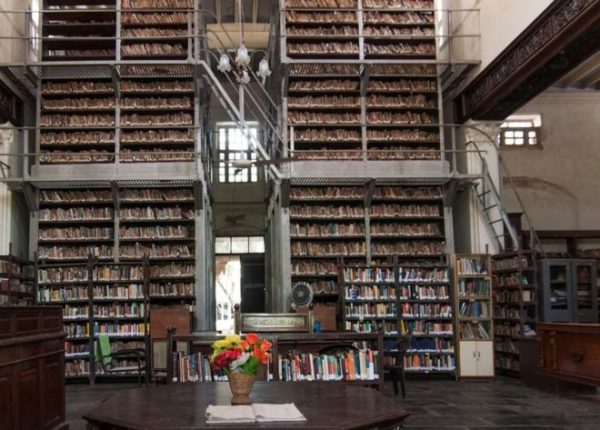The 204-year-old Madras Literary Society in Chennai is getting a new lease of life, thanks to youthful volunteers and a social media campaign. Karthik Subramanian finds out more.
The sight takes your breath away.
As you step in, you encounter bookshelf after bookshelf rising up from the floor to the ceiling. It is as though you have stumbled upon a waterfall of books. The Madras Literary Society library located in the centre of the south Indian city of Chennai, formerly known as Madras.
It houses more than 55,000 books, including a huge collection of tomes that are between 150 and 300 years old.
From outside, the imposing red brick building, which was constructed in 1905, looks like something out of a British period movie. The architectural style is typical of the Indo-Saracenic movement, favoured by the architects of British India in the late 19th Century.
Established by the East India Company in 1812 to train its employees in administration, languages, law, religion and “customs of the natives”, the library was initially located inside the Fort St George between 1812 and 1854 and moved to its current location in the year 1905.
One of the oldest books in its collection is Isaac Newton’s Naturalis Principia Mathematica (“The Mathematical Principles of Natural Philosophy”) published in the year 1729. It also contains memoirs and accounts published by the British officers of the Raj, such as “The History of Buckingham Canal” which was published in 1898.
But some of these are in a dire state and require immediate restoration, a process that costs from 5,000 rupees ($74; £58) to 12,000 rupees. Without adequate funds and staffing, the old books will soon turn to dust. Many already have.
But now, a group of young volunteers are stepping in to help.
“The first time I saw the shelves, I just went wow,” Rajith Nair, a 38-year-old entrepreneur and volunteer at the library told the BBC. “I have seen libraries like this only in the movies and thought they only existed in old libraries and museums of Europe.”
That was in June last year.
Since then, many youngsters have enrolled as members in the library. They are also actively recruiting other young people through projects like open house days, an adopt-a-book campaign and an aggressive social media strategy.
Thirupura Sundari Sevvel, a 26-year-old heritage consultant, is a regular at the open house the library conducts every Saturday. She helps in the conservation of books, and also trains volunteers to catalogue the titles.
One such recently restored book is a collection of cartoon prints by legendary political satirist James Gillray, which were originally published between 1798 and 1810.
They first caught the attention of author KRA Narasiah last year.
“I was writing a series in a newspaper about Buckingham Canal and was at the library doing some research when this book caught my eye,” he says.
“It was a serendipitous find. The comics were a wonderful example of political satire. I knew it was something special and had to be revived.”
The restoration work itself was carried out by P Renganathan, who has been restoring books for more than two decades now. The book of cartoons, he recalls, was in bad shape.
“It was affected by insects, had fungus and several water strains. I had it restored by encapsulating it in specially processed archival grade polyester films.”
Mr Mohanraman, the 73-year-old honorary secretary of the library, says the youth interest has been a huge lease of life to the library, which he believes “is caught between two worlds”.
“The Madras Literary Society was established to encourage scholastic work. This is one of the birthplaces of what we refer to as the Madras School of Orientalism. We want to preserve that aspect,” he explains.
“But it is also a circulating library that is still catering to its members. Most of our members are senior citizens, who prefer to read books in the physical form. Our challenge is to find a middle path and achieve both goals.” The library today has close to 350 members who each pay 850 rupees a year to access the rare books inside. The membership has actually doubled over the last 12 months, Mr Mohanraman says. He says that the goal is to reach a target of 1,000 members, which will help him realise his dream of restoring it to not just a vibrant lending library, but a thriving cultural centre.






Leave a reply